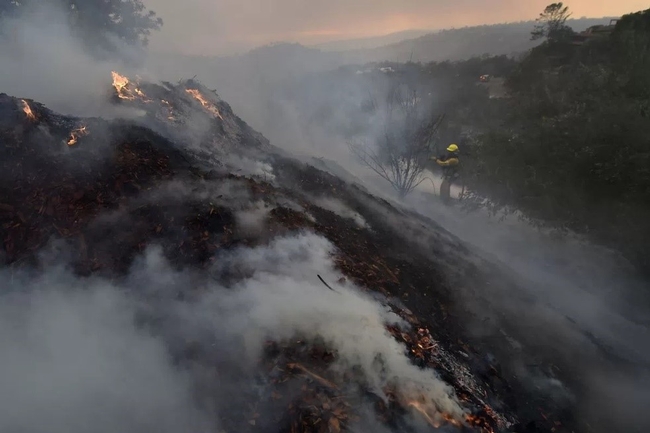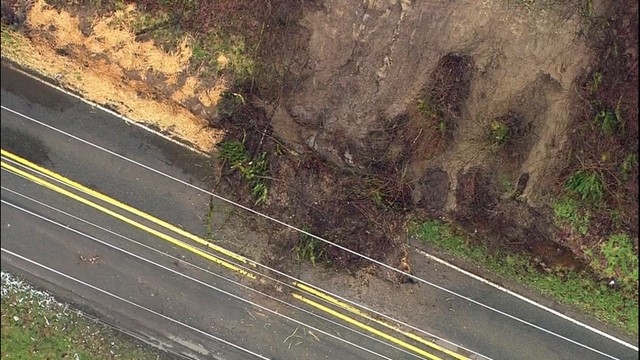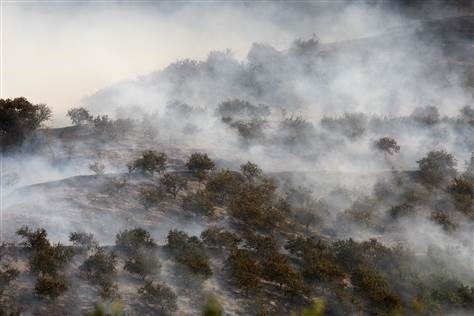Firefighters from all over the country worked around the clock to put out fires throughout the state of California. Fires could be devastating to growers and, in some ways, they could be beneficial by reducing populations of weeds and unwanted vegetation. However, after the loss of vegetation after a fire, growers have to prepare for the next possible disaster- mudslides, debris flow and flashfloods. Vegetation that once secured soil and gravel, preventing erosion on mountain and hill slopes is no longer there. Instead the waxy residue from burnt plant debris has formed into a baked waxy layer that prevents water from infiltrating more than a few inches into the soil, creating a water-proof surface layer. When a significant amount of rainfall occurs after a fire, it becomes an environment for a mudslide.
According to Randy Brooks, author of the article “After the Fires: Hydrophobic Soils,” during a fire, burning plants release gases from waxy plant substances that permeate through the soil pore space, coating soil particles with a hydrophobic substance, thus repelling water. Over time, the wax-like, hydrophobic layer that has formed a few inches below the soil could persist in repelling water causing damage years later. Orchard trees with shallow roots can be destroyed and/or develop weakened root systems if a mudslide occurs post-fire. As rain continues to fall, large chunks of topsoil can break loose and slide down sloped landscapes. In some cases, mud and debris can exceed 35 mph, causing massive damage and major mudslides.
Rapid moving mudslides can enter into infiltration basins, irrigation canals, and reservoirs moving silty-clay sand suspension sediment that could clog pumps and irrigation lines creating an expensive problem for growers.
Erosion in Orchards Post-Fire
Post-fire rains result in the transport of fertile soil particles into downstream waterways. These sediments can carry unwanted pesticides and nutrients that adhere to them. Erosion problems can include water pollution, loss of soil quality, increased flooding, impairment of stream ecosystems, decreased groundwater storage, release of carbon, slope failures, degradation of habitat and loss of species, damage to downstream lands and properties. Not to mention the amount of time and costs associated with addressing these issues.
Preventable Management Practices
Orchard floor management can include anything from the addition of soil amendments to changes in tillage practices. One way to minimize soil erosion is to implement management practices that improve soil structure. Soil structure is the arrangement of mineral particles into aggregates. A well-structured soil having stable aggregates can easily accommodate infiltrating water that decreases runoff and reduces erosion. In addition, stable aggregates resist particle detachment, prevent the formation of crusts, and are less susceptible to compaction. Light tillage where possible can break up the hydrophobic topsoil layer post-fire, followed by planting a cover crop, such as a grass or a forb can prevent soil erosion and be a moderate barrier in the event of a mudslide.
Mature avocado groves have high soil organic matter (SOM) due to leaf mulch and fine rootlets that die and decompose in the shallow soils. Soil organic matter promotes good soil aggregation and stable aggregates. The form of SOM that binds soil particles together into aggregates is called humus, which consists of highly decomposed organic material. Humus results from the breakdown of mulches, roots and any amended organic materials like compost or other supplemental mulches.
Periodic application of organic materials is a proven method for improving the water-infiltration capacity of certain soils: those that suffer from weak structure due to low organic matter content.
In many situations it is neither practical nor feasible to add soil amendments as an erosion control practice. Cover crops are an excellent alternative to reduce soil erosion. They protect the soil from raindrop impact, prevent the formation of surface crusts, increase infiltration rates, and intercept sediment-rich runoff. Cover crops are also a great source of SOM. Critical aspects to consider are nutrient and water competition with crops, cost of additional water for irrigation, shade tolerance, crop height, and maintenance practices such as mowing.
Like most management practices, cover cropping has disadvantages, too. All cover crops use water, some are invasive, some serve as habitat for pests, some can increase the potential for frost damage, and they may be costly to establish.
Management practices are ever changing for prevention and protection of orchards every year especially against fire and mudslides. Being informed and assessing the situation post-fire adds value to how we can evaluate the cost of protecting orchards and economically prepare fields from mudslides damages.


